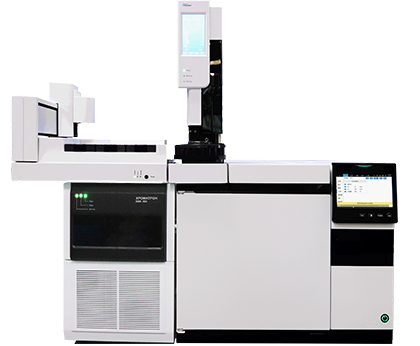


Instrument Type: Single-Quadrupole Gas Chromatography-Mass Spectrometry (GC-MS)
1 Operating Environment
1.1 Ambient temperature: 15-35℃;
1.2 Relative humidity: ≤85%;
1.3 Applicable power supply: 220V (±10%), 50Hz (±2%);
2 Parameters of Single Quadrupole Mass Spectrometer
2.1 Main Performance Indicators
2.1.1 Sensitivity: 1 pg Octafluoronaphthalene (OFN) with a signal-to-noise ratio (S/N) of ≥1500:1; instrument detection limit (IDL) better than 10 fg OFN;
2.1.2 Mass Range: 4-1200 amu (able to observe the peak of m/z 4 in the helium spectrum and the peaks of m/z 1166 amu or m/z 1185 for trans-Perfluorotripropylamine);
2.1.3 Mass Stability: ± 0.10 amu/24 hours (based on two tuning results within 24 hours, with ambient temperature fluctuations <2℃);
2.1.4 Mass Accuracy: ± 0.10 amu;
2.1.5 Maximum Scanning Speed: 20,000 amu/s, adjustable throughout the entire speed range;
2.1.6 Resolution: 1.0 amu;
2.1.7 Dynamic Range: 106;
2.1.8 Peak Area Reproducibility: <3% RSD;
2.1.9 Scanning Modes: Full scan, selected ion monitoring, simultaneous full scan and selected ion monitoring, alternating scan;
2.2 Ion Source
2.2.1 Ion Source Type: Electron Impact (EI);
2.2.2 Ion Source Configuration: Inert ceramic ion source with dual filament software switching;
2.2.3 Filament Current: 0-300 μA;
2.2.4 Ionization Energy: 5-100 eV;
2.2.5 Ion Source Temperature: 50℃-350℃;
2.2.6 The ion source and quadrupole are located in separate chambers, allowing maintenance of the ion source and filament without exposing the quadrupole;
2.2.7 Equipped with a filament observation window for intuitive determination of the filament's operating status;
2.2.8 Interface Temperature: 50-350℃;
2.3 Mass Analyzer
2.3.1 Mass Analyzer: Equipped with a high-precision all-metal quadrupole rod with a pre-quadrupole, ensuring mass stability without the need for temperature control of the quadrupole rod.
2.3.2 The pre-quadrupole is removable and washable, preventing contamination of the main quadrupole rod.
2.4 Detector
2.4.1 Long-lifetime 13-stage discrete dynode electron multiplier.
2.4.2 Equipped with a 10kV switching dynode and a lens system for removing neutral noise.
2.5 Vacuum System
2.5.1 Pumping speed of the backing pump: 4 m³/h.
2.5.2 Equipped with a high-performance turbo molecular pump with a pumping speed of 250 L/s.
2.5.3 Maximum allowable chromatographic column flow rate: 5 ml/min (helium).
Parameters of Gas Chromatograph
3.1 Oven
3.1.1 Temperature range: 5˚C-450˚C above room temperature;
3.1.2 Temperature control accuracy: ≤0.01℃;
3.1.3 Programmed temperature rise: 30 stages and 31 platforms;
3.1.4 Heating rate: the maximum heating rate of the furnace is 120˚C/min;
3.1.5 Cooling rate: When the room temperature is 20℃, the furnace cools from 450˚C to 50˚C in ≤6min;
3.2 Injection Port
3.2.1 Split/Splitless capillary column injection port;
3.2.2 Maximum operating temperature:450˚C;
3.2.3 High-precision electronic pressure/flow control;
3.2.4 Pressure setting range: 0-100 psi, with a control accuracy of 0.001 psi;
3.2.5 The injection port features four modes: pulsed split, pulsed splitless, split, and splitless;
3.2.6 Column control modes: constant flow, constant pressure, programmed flow, programmed pressure, etc.;
3.2.7 Maximum split ratio ≥7500;
3.2.8 Total flow setting range: 0-1000 mL/min (helium);
4 Liquid Automatic Sampler
4.1 Equipped with a 24-position sample tray;
4.2 Adjustable sampling depth and injection depth;
4.3 Automatic syringe cleaning function before and after injection: automatic cleaning with solvents A and B;
5 Software Workstation
5.1 Full English integrated control for MS and GC, with manual/automatic tuning;
5.2 Synchronous scanning function allows obtaining both Scan and SIM data from a single injection, improving analysis efficiency; alternating scanning function enables alternating between Scan and SIM, expanding analytical capabilities;
5.3 The ability to set time intervals to turn off the filament and electron multiplier during operation to protect them from solvents or other easily saturated substances that peak in the middle;
5.4 The software can automatically select characteristic ions of target compounds based on full scan data, group them, automatically set ion dwell times, and save them to analysis methods without manual input;
5.5 Data format is deconvolution AMDIS readable, directly used for co-eluting peak analysis;
5.6 Chromatographic flow monitoring; automatic temperature reduction protection for the MS ion source and transmission line, and MS shutdown in case of chromatographic gas cutoff;
5.7 Real-time monitoring of molecular pump speed and current, with abnormal prompts and one-click automatic shutdown.
5.8 Selected ion monitoring (SIM) time grouping with 100 groups, each group can select up to 108 ions, with a minimum dwell time of 6ms.
5.9 Ability to set different electron multiplier voltage values at different time intervals.
5.10 Data analysis software with NIST spectral library search function and self-built library function, supporting self-built libraries.
5.11 Equipped with quantitative batch processing function and report editor;
5.12 Automatic completion of quantitative calculations and generation of quantitative reports after instrument acquisition.

Linked in


Whats App




